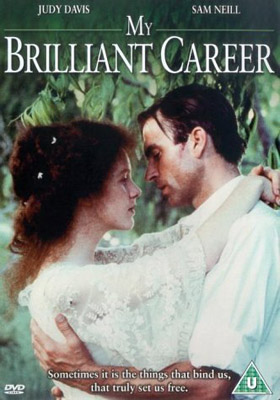
A few years ago, I interviewed Aussie actor Peter Whitford about the making of Gillian Armstrong’s classic movie My Brilliant Career. The 1979 masterpiece, based on the Miles Franklin book of the same name, tells the story of a young Australian girl growing up in the early 20th century who turns her back on love to maintain her independence and follow her dreams of becoming a writer. The movie helped launch the careers of Sam Neill and Judy Davis and featured a stellar cast including Wendy Hughes, Robert Grubb, Max Cullen, Aileen Britton and Peter Whitford.
This is an excerpt of the story based on the interview:
In the late seventies, Peter Whitford met with Gillian Armstrong, a film director who had just graduated from film school and was about to tackle her first movie, My Brilliant Career, the autobiographical novel by Miles Franklin. Gillian wanted to shoot the movie in the same style as Australia’s great Impressionist painters, a style that was later adopted by Dean Semler for the filming of Dances with Wolves.
In those days, directors were regular theatre goers and knew how to pick actors for their projects. They would do their own casting rather than go through casting agents. Gillian asked Peter to read for the part of Uncle Julius, a well-traveled bachelor and man of leisure living off the family fortune. “When we met,” says Whitford, “she described the role of the uncle very well. She asked me whether I’d be willing to grow my own beard and because I thought it sounded like a lot of fun I accepted. These days, actors demand a fee when a certain look is required of them. The reason being that growing a beard or altering their hair can limit the amount of work they get.”
On the first day filming My Brilliant Career, Peter remembers having to ride around on a 1890s bicycle. The scene was shot at the back of Elizabeth House near Camden. The filmmakers didn’t just shoot exteriors of the house but also used interiors for sequences such as the big dining scene early on in the film. There were no sets on My Brilliant Career except at the very end when Sybilla played by Judy Davis is sent to the Mc Swats’ farm to be a tutor. The ramshackle homestead belonging to the Mc Swats had to be built specially for the movie in a location near Hay.
Peter’s character, Uncle J-J, was a whisky-drinking, cigar-smoking kind of man. “I used to harass Gillian during the shoot,” he says, “asking her whether I could smoke a cigar in a particular scene. ‘No, you can’t’ would be the usual reply. This happened over and over again until we finally did a night shoot in a house in Michelago in southern New South Wales. Naturally it was a stinking hot day which meant that all the windows had to be sealed to keep out daylight. So we’re sitting in an airless room next to a crackling fire as it is supposed to be a cold winter’s night and we’re literally melting away by the second.”
“Just before we shot the scene Gillian said to me ‘OK Petey, you can have a cigar’ and that was about the only time I got to smoke in the film. So much for the line in the script about Uncle Julius always smelling of whisky and cigars! I had pictured myself rolling around the house throughout the movie, cigar in one hand ‘à la Groucho Marx’ and a slosh of Whiskey in the other just like W.C. Fields. I quite fancied the idea.”
My Brilliant Career was Sam Neill's first major movie as it was Peter’s. At the time Neill was crossing over from editing to being an actor. “At one particular point during one of the dance sequences,” recalls Whitford, “Sam called me over and asked whether I could check the size of the camera’s lens. He was already able to tailor a performance, even at that point in his career.”
It always amazes Peter how much technical knowledge actors pick up on a set although, personally, he likes to keep things simple. “I love Michael Caine talking about the craft of filming,” he says. “Caine always cuts to the chase.” Peter begins his Michael Caine impersonation – and a very convincing one at that! “’When you’re talkin’ to somebody else, you always look in their eye, the one closest to the lens. That means a bit more of your face is turned towards the camera.’”
“I can work with that,” says Peter, “but I wouldn’t know one lens from another. I am in love with the making of movies but I don’t want to know how it all works; I just like being part of it.”


No comments:
Post a Comment